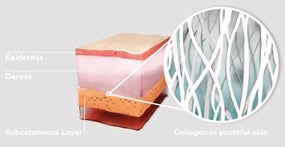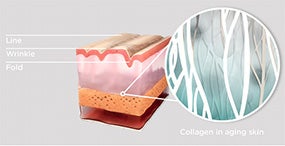
In this article, we discuss why collagen is such an important key protein for maintaining a youthful appearance. Find out what you can do to prevent and treat typical signs of collagen loss such as the appearance of lines and wrinkles, skin folds, and saggy skin.
What is Collagen?
It is the most abundant protein in the human body (also called structural proteins). Collagen provides structure and support to the entire body, including bones, cartilage, ligaments, muscles, blood vessels, skin, and more. This connective tissue literary holds our bodies together.
Collagen can be rigid, as it is in bones, teeth, and cartilage. Or it can be compliant, as it is in skin and tendons.
How Does the Collagen in Your Skin Work?
Collagen in skin is primarily located within the middle layer of the skin, also called the dermis. The dermis is below the outer layer of our skin (the epidermis) and above the hypodermis (the bottom layer), which contains fat cells.
In our skin, it acts as a building block for skin volume, skin elasticity, and softness. With dermal fillers, the following powerful ingredients can help you achieve younger-looking skin:
- Fibrous collagen proteins provide the skin with structure and support
- An elastic protein called elastin maintains skin's shape
- A gel-like substance called hyaluronic acid preserves skin hydration
More collagen in our skin encourages more elastin and hyaluronic acid, since it gives our skin structure and support. This is why collagen loss in skin is one of the main reasons for visible facial ageing, such as wrinkles and saggy skin.
Why does the collagen in our skin decrease as we age?
Internal factors and external factors can contribute to the natural loss of collagen in our skin. Facial ageing begins in your 20s. These natural ageing and genetic factors contribute to a loss of collagen.
External factors such as sun exposure, stress, smoking, and more can also lead to a loss of collagen in the skin. This leads to thinner and structurally weakened skin. Most people will have a 20% collagen loss by the age of 40, and up to 30% collagen loss by the age of 50.
Saggy Skin, Deep Folds, and Wrinkles Appear as We Lose Collagen
Visible signs of ageing start to appear with the loss of collagen. These signs can include wrinkles, deep folds, and saggy skin. Other changes that occur as we age can also influence our facial skin.
These could, for example, include bone reabsorption and subcutaneous fat in the hypodermis. These other changes could further aggravate skin folds and wrinkles, and make saggy skin more noticeable.
The images below illustrate the loss of support and structure in ageing skin compared to young skin.
As you can see in these images, ageing skin does not have as much support from collaged. This is, in part, the cause of saggy skin and why wrinkles and skin folds begin to appear.
How to Prevent Collagen Loss in Ageing Skin
To reduce collagen loss in your skin, you can avoid exaggerated sun exposure. You can also make other lifestyle changes and cut out elements that have a negative impact on skin collagen, such as smoking, alcohol, and stress.
Once we have lost a percentage of collagen in the skin, it is difficult to restore it with externally. Collagen molecules are too big to penetrate the outer layer of your skin. Any topically applied collagen will just form a temporary layer on the skin's surface.
Since you cannot treat it effectively from the outside, filler injections become a vital part of restoring your skin's collagen.
What Are the Treatments that Stimulate Collagen Synthesis in the Skin
As collagen is such a key component for healthy and youthful skin, there are a number of different treatments that aim to stimulate collagen synthesis in the skin.
1. Trauma-Based Treatments
There are various treatments that aim to stimulate collagen synthesis in the skin, since it is such a key component for healthy, youthful skin. Some treatments purport to stimulate skin renewal by causing a controlled injury or trauma to the area. These can include laser skin resurfacing, microdermabrasion, micro-needling, ultrasound, and radio frequency treatments.
The trauma is supposed to trigger a healing process that aims to rejuvenate skin. As a result, the desired effect would be a reduction in saggy skin and the appearance of wrinkles. Each of these procedures carries a level of risk dependent on the degree of trauma.
2. Biostimulators
A second category of treatment to consider is biostimulators. These types of treatments use a different mode of action to achieve results. Medical professionals inject specific substances into the deep dermis layer, where they will activate collagen synthesis.
Different products and brands use different substances to achieve this activation. Bio-stimulators are biodegradable, meaning that they will disappear from the skin with time.
Biostimulators are powerful and can restore the skin structure gradually. It also carries the risk of side effects, but it does not use trauma to stimulate collagen renewal. This makes it the preferable option for many South Africans looking to address their skin issues with an aesthetic procedure.
Further Reading on Collagen Treatments
There are many types of skin rejuvenation treatments on the market. The articles below will give you a better idea of the available options and treatment that will work best for you.
How Effective Are Aesthetic Treatments at Collagen Stimulation?
This article provides more information about the different types of collagen treatments, their modes of action, and the risks and benefits of each.
How to Use Biostimulator Collagen Treatments to Restore Aged Skin
In this article, you can learn more about how bio-stimulators activate the natural collagen production in skin.
REFERENCES
"1. Vleggaar D, Fitzgerald R. Dermatological implications of skin ageing: a focus on supraperiosteal volumization for perioral rejuvenation. J Drugs Dermatol. 2008;7:209-220.
2. Farage MA et al. Adv Wound Care (New Rochelle) 2013;2(1):5–10.;
3. Quan T and Fisher GJ. Gerontology 2015; 61(5):427–34
4. Shuster S, Black MM, McVitie E. The influence of age and sex on skin thickness, skin collagen and density. Br J Dermatol. 1975;93:639-643."

